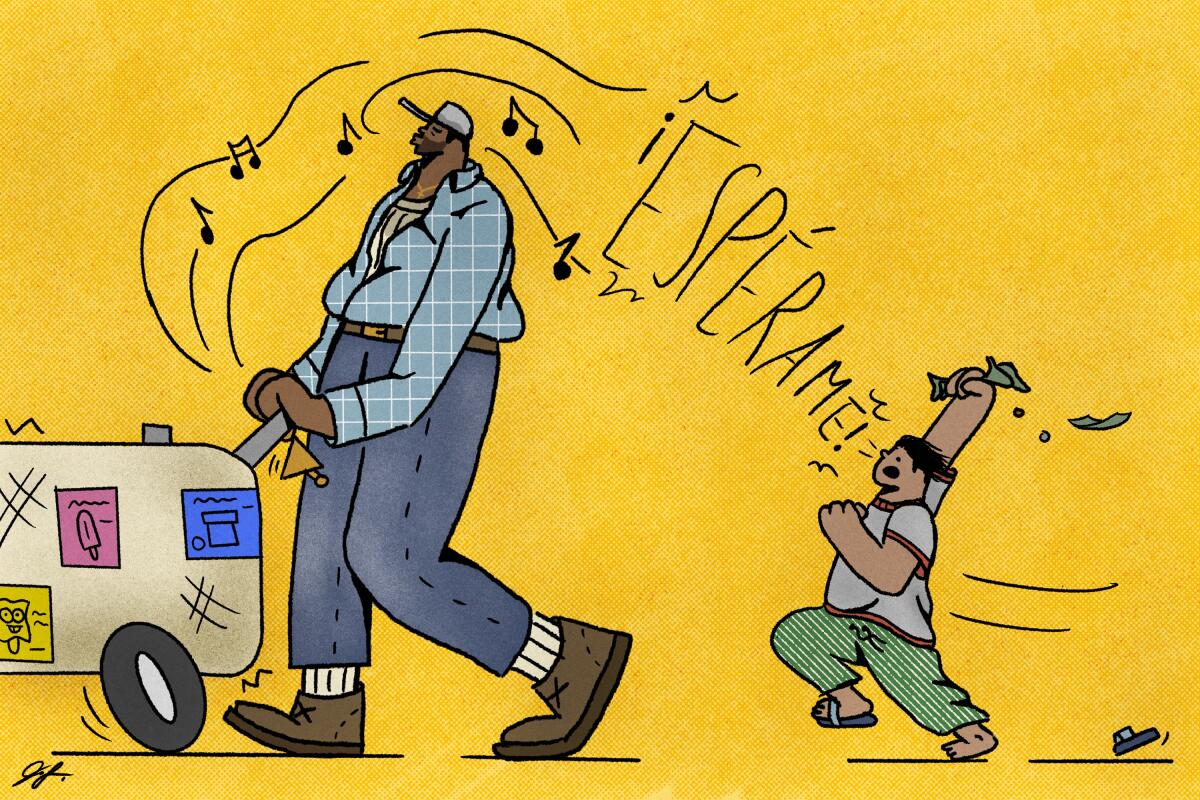Latinx Files: El corrido de Jenny 69

Fourteen seconds. That’s all it took for Jenny 69 to go viral.
On Sept. 29, the beauty influencer — real name Jennifer Ruiz — uploaded a clip to her Instagram page teasing “La 69,” her forthcoming debut corrido. Within days, the 14-second fragment of the music video started racking up serious views.
It also spread to other social media platforms, where “Soy la 69, soy la chingona que salió de Riverside,” the opening salvo of what’s now the latest certified banger of the korrido kitsch subgenre, became instant fodder for much of Paisa Internet and other subsets of the broader Latinternet.
“La 69” became a meme. It also became a hit after it was released Friday. I reached out to Ruiz for an interview, but she didn’t respond.
On TikTok, the audio of the original clip served as aural background for hundreds of videos. Some of them have since garnered millions of views, including this one from a doughnut shop in Riverside. (A special shoutout to Tomás Mier, a writer at People magazine, former Times intern and my go-to TikTok trend guide, for giving me the heads-up about the song’s spread on the app.)
On Twitter, where I first saw it, it spawned discourse. Mexican Americans in Texas used the meme to take shots at Mexican Americans in California. Angelenos used it to poke fun at their next-door cousins. People from Riverside either denounced Jenny 69 or the city itself, while others embraced it and got in on the fun.
The meme even made its way out east to another Jenny que salió de Riversai.
By her own admission, Jennifer Medina is not “a very online person,” mostly tweeting about topics pertaining to her job as a national politics reporter at the New York Times. But even she caught the “La 69” earworm after trying to find out why “Riverside” was trending on Twitter.
“It’s as simple as hometown pride and excitement about it,” Medina told me when I asked her why she liked the song, adding that she also wasn’t a music person. What she did know was that “La 69” was stuck in her head.
“I felt like, ‘Oh! This should be my anthem!’”
The Latinx experience chronicled
Get the Latinx Files newsletter for stories that capture the multitudes within our communities.
You may occasionally receive promotional content from the Los Angeles Times.
Is “La 69” a good song? The overwhelming majority of YouTube commenters who chimed in would laugh at you for suggesting that. Then again, what’s good is not always popular, and what’s popular is not always good.
Make no mistake, “La 69” is very popular. It’s been the top trending music video on YouTube for much of this week, where it’s amassed more than 3 million views as of this writing. “La 69” was also among the 25 most played songs in Los Angeles on Apple Music during that same time period. On Spotify, it is closing in on 300,000 plays.
I asked Pablo Valdivia, a senior editor at Buzzfeed’s Latinx vertical, “Pero Like” (and a seasoned meme expert, in my point of view), to explain the Jenny 69 phenomenon.
“Remember when Rebecca Black released ‘Friday’ in 2011 and everyone loved to hate it,” he said, “up to the point where they began listening to it unironically?
“Jenny’s taken up that mantle within the Latinx community. Of all the things that create division between us, clowning on this corrido isn’t one of them.”
In a short timespan, “La 69” has become an internet cultural moment. And it’s completely ours.
Medina said she struggled to explain the earworm to monolingual English speakers. “It’s not on their radar at all.”
Not that she minded.
“I’m not usually in on the internet joke, so it’s fun to be in on it for once.”
For better or worse, “La 69” has become part of our online vernacular, part of a secret language only those with cultural fluency can understand. It’s la caida de Edgar. Son Reebok o son Nike. In the words of Pusha T, if you know, you know.
As for Ruiz, the online ridicule doesn’t seem to have affected her much. The Instagram influencer has been busy basking in the glory of her notoriety and bragging about her newly acquired troca mamalona.
We may think she’s not in on the joke, but it could very well be that the joke is on us.
Our daily news podcast
If you’re a fan of this newsletter, you’ll probably love our new daily podcast, “The Times,” hosted by columnist Gustavo Arellano, along with reporters from across our newsroom. Every weekday, it takes you beyond the headlines. Subscribe on Apple Podcasts and follow on Spotify.
Random thoughts and questions I had while watching the ‘La 69’ music video for the first time
00:07 — A vintage Processo magazine. Didn’t realize Jenny 69 was up to date on Mexican politics.
00:26 — Who is the paisa responsible for making Buchanan’s blended scotch whiskey the status liquor of choice for much of the Mexican American diaspora? I’d like to have a word and tell him better spirits exist.
00:50 — A Death Row Records T-shirt. What’s the equivalent in the genre? Maybe Rancho Humilde?
01:35 — Say what you want about this song, but the ad-libbed line “From a pobrecita to a bad b—!” would make a top-tier tagline in the opening credits of “Real Housewives of Riversai.”
02:48 — La mamalona de la Jenny, si quema cuh? Also how much mileage do you think that truck gets? 15 mpg?
Things we read this week that we think you should read
— The final episode of “Loud: The History of Reggaeton” was released this week. Culture writer Daniel Hernandez wrote about how the groundbreaking Spotify podcast got it right.
— Back in June, Tina Vazquez wrote about becoming her father’s retirement plan for the Lily, a reality that many children of immigrants (myself included) have no doubt entertained or accepted. Last Thursday, her emotionally open and vulnerable essay made the online rounds after Vazquez posted a video of her dad walking out of the hospital he worked at after finishing his last shift.
— Earlier this week, the Los Angeles Times republished a digital version of “Black L.A.: Looking at Diversity.” The 1982 series — written, reported and photographed by Black staffers — was not submitted for Pulitzer Prize consideration, though its impact is no less important. Not only did it provide a more accurate view of Black life in L.A., but it also served as inspiration for The Times’ “Latinos” series, which won the Pulitzer for public service.
— Ahead of tonight’s CONCACAF World Cup qualifying matches, Roberto José Andrade Franco profiled Ricardo Pepi, the teenage soccer phenom who broke many hearts, mine included, when he decided to play for the U.S. men’s national team instead of Mexico’s. I am biased here — Roberto is a dear friend of mine — but this feature is more than just a soccer story. It’s some of the most beautiful writing on the borderlands I’ve read in quite some time.
Consider subscribing to the Los Angeles Times
Your support helps us deliver the news that matters most. Become a subscriber.
And now for something completely different….

Jonathan Funes is a Salvadoran American illustrator and graphic designer born and raised in Los Angeles. His illustration work is inspired by the overlooked sights and seemingly mundane activities of day-to-day life, like getting a haircut or wearing a new pair of pants.
“My focus for this piece is the staple of most neighborhoods in L.A.: the paletero,” Funes says. “Because beyond ice cream, our paleteros bring a sense of community to our neighborhoods and local gatherings. They give us the childhood thrill of hearing their carts’ bells and bolting down the block to get an ice cream or raspado. Ultimately, I wanted to represent the paletero as the joy-spreading, hardworking individuals they are.”
Are you a Latinx artist? We want your help telling our stories. Send us your pitches for illustrations, comics, GIFs and more! Email our art director at [email protected].
The Latinx experience chronicled
Get the Latinx Files newsletter for stories that capture the multitudes within our communities.
You may occasionally receive promotional content from the Los Angeles Times.




